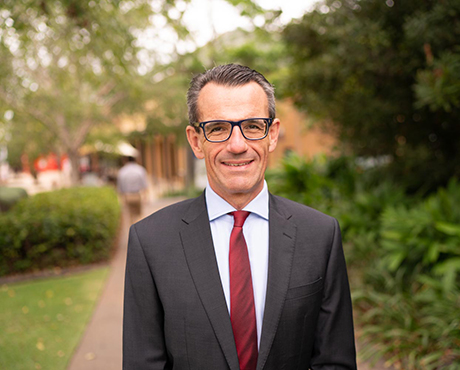
Have you visited Viva Engage yet?
News 11 JuneViva Engage is here. Access it easily via Microsoft Teams.
04 May 2022
Share
ACU students start their degrees in teaching, social work, nursing and other social sciences with a passion to contribute to their fields in a meaningful way. Are they equipped to support child wellbeing and safety? How can ACU prepare them to respond to children at risk?
According to ACU Provost and Deputy Vice-Chancellor (Academic) Professor Meg Stuart, our university needs to prioritise helping our students to go into their fields armed with the best knowledge about how to respond to children at risk.
“Our graduates need to be equipped to carry our mission to uphold the dignity of the human person into their professional lives. Having adequate safeguarding knowledge and skill is an essential component of their professional repertoire.”
Unfortunately, the workforce for preventative and supportive services in the child protection system is poorly defined and resourced.
In a national study, Trends and needs in the Australian child welfare workforce: An exploratory study, published by ACU’s Institute of Child Protection Studies, data shows that there has been an increase in the need for specialist services.
Sadly, those services are geared towards removal of children from their families. Too many children are taken into care, particularly Aboriginal and Torres Strait Islander children, and too many do not receive the care they need.
Tertiary education needs to align with future workforce needs. The report found that in the past decade, the workforce numbers in frontline child welfare in statutory agencies increased from 10,000 staff to 18,000 staff.
Australian families have ongoing contact with education, social welfare, health and other services. Universal access to these services can better support children and their families without the stigma of having ‘failed’. More preventative, early intervention is needed to support children to remain safely with their families.
Demand for preventative support for children and families experiencing adversity continues to increase, yet the current workforce is unable to meet this demand. This increases the pressure on child protection systems and their workers who have to respond to complex situations often with inadequate training or skills and limited experience.
Improved public policy could work to address some of these issues. Proper planning for growth in the child welfare sector, increasing and upskilling the workforce to provide preventative support to families, and increasing diversity within the workforce would be a start
The study finds that a preventative approach would help professionals whose work brings them face-to-face with children to develop the skills and knowledge necessary to identify and respond to the risk factors. The most effective way to deal with child abuse and neglect, and promote child safety and wellbeing, is to offer families and children specialist support sooner rather than later, and to offer support that is culturally appropriate, and meaningful.
ACU is in an influential position to collaborate with child welfare sectors and work together to plan for the continuing demand and future needs in child welfare services.
Professor Stuart believes that ACU has the potential to be a national and international leader in this space, “It can be a significant point of difference between our graduates and others who do not share our mission, and a key feature of what ACU can offer to bring to key partnerships.”
ACU can embed a strong component of safeguarding practice into curriculum and pedagogy across faculty courses. Students could be offered robust child safeguarding content in their undergraduate or postgraduate courses. ACU could deliver short online courses that are micro-credentialed into a graduate certificate.
Such courses could be supported and promoted as key assets of the university, building on the significant role the university played in research for the Royal Commission into Institutional Responses to Child Abuse.
This wide range of measures that upskill workers in child welfare can address vulnerability early and help to reduce demand on child protection systems and support all children and their families.

Viva Engage is here. Access it easily via Microsoft Teams.

The library is supporting the ACU Historical Children’s Book Collections 2025 Fellowship. It is an opportunity to conduct research on our historical collection of children’s books, located at St Patri...

A new Adjunct and Honorary Titles Policy and Procedure has been approved and is now in effect at ACU.

Teaching staff are encouraged to check their units have been correctly linked to their names for the Student Evaluation of Learning and Teaching (SELT) surveys in upcoming teaching periods.

On 24 June ACU will transition to the new EBSCOhost. This will result in a new look and feel across some of our most popular databases. Learn more about the changes and what action may be required of ...

Include an additional survey item in the Student Evaluation of Learning and Teaching (SELT) survey for units that are offered in ACU Online Term 2 (202536).

Advance your career in teaching and learning with the Graduate Certificate in Higher Education. Enrol by 22 June to get started in Professional Term 5.

ACU has three student modules: the Academic Integrity, Respectful Relationships, and Protecting our Children modules. Semester 1 students must complete their modules by 1 July to access their results ...

The Student News and Events bulletin is sent to all students, nationally, and includes a broad cross-section of news, announcements, events and stories from across the university. The May edition is o...

Please be aware of the following changes to payroll processing dates.

A message from the Chief Operating Officer Patrick Woods.

As part of Student Administration's commitment to service excellence, AskACU will be running on-campus re-enrolment drop-in sessions in July, while CMAS enhancements will improve information available...

Say goodbye to Workplace and hello to Viva Engage. Learn about our new community structure and all-staff community.

An update from the Executive Dean of Law and Business Professor Andrew O'Neil.

A reminder to all academic staff that the mandatory Notice of Intent, for those intending to apply for promotion in the 2025 round, must be submitted by 11.59pm this Friday (30 May).

Expect a few email notifications as we prepare to welcome you to Viva Engage next week.

Include an additional survey item in the Student Evaluation of Learning and Teaching (SELT) survey for units that are offered in Professional Term 4 (202547).

Register for these 15-minute sessions to learn more about the variety of online researcher profile platforms and what is involved in setting up, linking and updating your profile.

ACU is developing a new Education and Student Success Plan to ensure our university continues to provide a high-quality, student-centred learning experience. Find out how you can contribute to the pla...

Lecturers-in-charge can make a direct determination of Poor Academic Practice (PAP) for students who engage in minor forms of academic misconduct. Learn why they can be valuable to staff and students.
Visit Service Central to access Corporate Services.